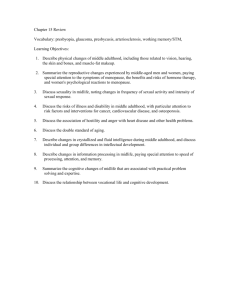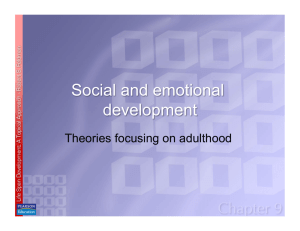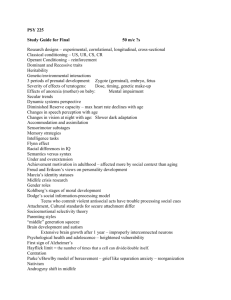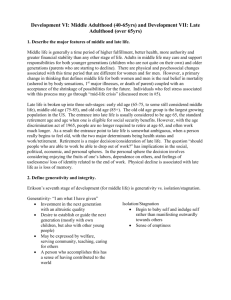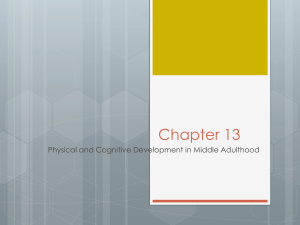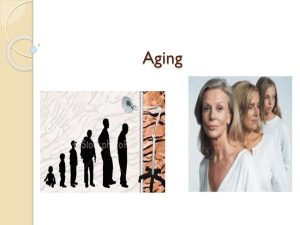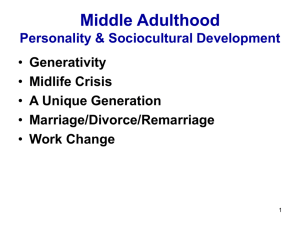EXAM 4 LECTURE NOTES
advertisement
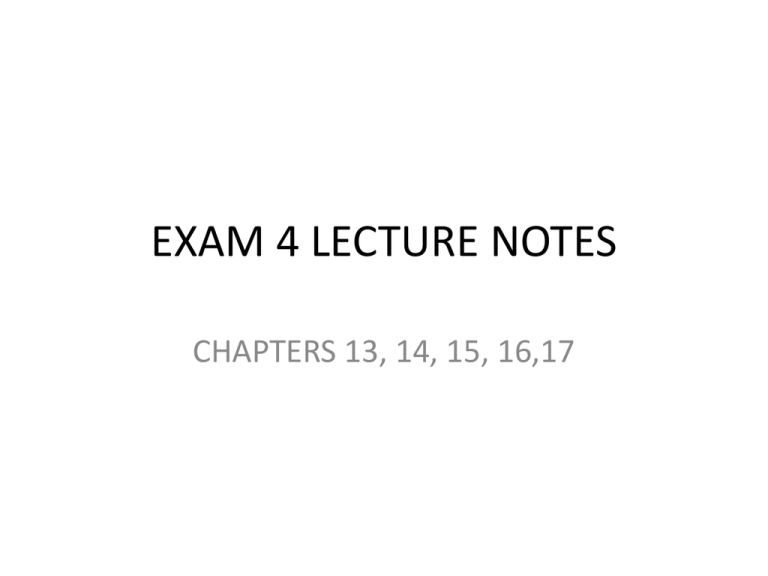
EXAM 4 LECTURE NOTES CHAPTERS 13, 14, 15, 16,17 • Chapter 13: Physical and cognitive development in middle adulthood • (344-361) 1. Defining middle adulthood (346) • Approximately 40 to 60-65 years of age. • Declining physical skills and expanding responsibilities • Balancing work and relationship responsibilities • With physical and psychological changes associated with aging 2. Middle adulthood likely includes: • Death of parents • Last child leaving home • Becoming grandparent • Preparing for retirement • Actual retirement • Physical development • Skin begins to wrinkle and sag • Loss of fat and collagen in underlying tissues • Small localized areas of pigmentation result in aging spots • Thinning and graying hair • Fingernails and toenails thicker and more brittle 3. Height and weight (347) • Begin to lose height • Men: average ½ inch, from 30-50; ¾ inch from 50-70 • Women: up to 2 inches from 20-75 • Many people gain weight • Average 20% body fat during midlife • Being overweight or obese critical health problem in midlife • Increases likelihood for developing hypertension, diabetes, digestive disorders 4. Strength, joints, bones (348) • Sarcopenia: age-related loss of muscle mass and strength • Exercise reduces rate of developing sarcopenia • Cartilage, tendons and ligaments become less efficient • Decline in bone density begins mid-late thirties and accelerates in 50’s 5. Vision and hearing • Accommodation of eye declines most between 40-59 • Difficulty focusing on near objects • Hearing begins decline about age 40 • First lose sensitivity to high pitch sounds 6. Cardiovascular system • High blood pressure and high cholesterol noticeable • Fatty deposits and scar tissue develop on walls of blood vessels • Cholesterol collects on wall of blood vessels • Result in reduce blood flow to brain and heart • Exercise and healthy eating including fruits, vegetables and grains delay cardiovascular problems 7. Lungs (349) • About age 55, proteins in lung tissue become less elastic • Gradual stiffening of connective tissue in chest wall combines • result in decrease in lung capacity to bring oxygen to veins • Smokers have especially low lung capacity 8. Sleep • Total hours of sleep remains stable • Beginning in 40’s, increasing frequency of wakeful periods • Less frequent stage 4 (very deep) sleep 9. Health and disease • Decrease frequency of accidents, colds, allergies for some • Stress increasingly a factor in disease, especially in immune system and cardiovascular system • Mortality rates (350) • Chronic diseases more likely cause of death than infectious diseases • Most likely a single, identifiable condition • Heart disease, cancer and cerebrovascular disease 10. Sexuality • Menopause: usually late 40’s or early 50’s in women • Menstrual flow stops • Timing and side effects vary widely • Side effects result from decline in estrogen • Include hot flashes, nausea, fatigue and rapid heartbeat • (351) • Side effects experiences vary widely, especially across different cultural and ethnic groups • May not be a negative experience for most women • Loss of fertility is important marker • Hormone replacement therapy controversial • Consists of forms of estrogen and progestin • Some HRT recipients developed increased risk of stroke and dementia • HRT study found lower risk of hip fractures and no increase in risk for heart attack or breast cancer • Hormonal changes in middle-aged men • Modest decline in sexual hormone level and activity • May be more psychological than physical • (352) • Gradually reduced sex drive • Erections less full and less frequent • Erectile dysfunction may be psychological and/or physical • Smoking, diabetes, hypertension and elevated cholesterol contribute to erectile problems 11. Sexual attitudes and behavior • Activity less frequent compared to early adulthood • Increasing career interests, family matters, lower energy levels, changing activity routines contribute 12. Fluid and crystallized intelligence • (353) • Fluid: ability to reason abstractly declines in midlife • Crystallized: accumulated information and verbal skills increase in midlife • Data from cross-sectional study (Horn and Donaldson, 1980) • Differences may have been because of cohort effects • Whether data collected in cross-sectional or longitudinal study affects results on crystallized and fluid intelligence 13. Seattle Longitudinal study beginning in 1956 • (354) • Schaie,1996; Willis & Schaie, 2005) • Tested vocabulary, verbal memory, spatial orientation, inductive reasoning, perceptual speed, numerical ability • Highest level functioning in midlife for first 4 areas tested • Two abilities showed decline in midlife: numerical ability and perceptual speed • Schaie’s results indicate cognitive funtioning peaks in midlife, not early adulthood 14. Information processing • Speed of information processing • Declines beginning in early adulthood and continues in midlife • Commonly measured using reaction-time task • Press a button when a light appears 15. Memory • (355) • Denise Park (2001) proposed more time required to learn new information beginning in midlife • Slowdown may be linked to changes in working memory (short-term memory) • Working memory allows manipulating and assembling information • especially - • making decisions, • solving problems, • understanding written and spoken language • Memory decline most likely if not use strategies such as organization and imagery • Can improve memory in midlife if organize (phone) numbers in different categories or imagine the numbers representing different objects in a familiar location 16. Expertise • Most evident in midlife, possibly because of time needed to develop • Involves highly organized knowledge and understanding of a particular domain • Experts more likely to -- • rely on accumulated experience to solve problems • Process information automatically • Analyze information efficiently • Devise better strategies • Use shortcuts to solve problems • Be creative and flexible in solving problems 17. Careers, work and leisure • Work in midlife • Role of work usually central in midlife • Middle-aged adults also may have multiple financial responsibilities, • Often reach peak in position and earnings • • • • • Career paths are diverse Some have stable careers Others move in and out of work force Age discrimination common in midlife Midlife often a time of evaluation, assessment and reflection about employment • • • • Midlife employment issues: Recognize limitations in career progress Decide whether to change jobs or career fields Decide whether to change balance in work and family responsibilities • Plan for retirement 18. Career challenges and changes • • • • • • Challenges include - Globalization of work Rapid technological developments Organizational downsizing Early retirement Health care • Globalization has resulted in a workforce of employees with different ethnic and cultural backgrounds • Increased computer technology means increased computer literacy necessary for effective competition in the workforce • Increased frequency of restructuring, downsizing and outsourcing - • Result: increased incentive to retire early • Midlife career changes vary in motivation • Some self-related: • desire for change in type or amount of responsibility • adjustment of idealistic hopes to realistic possibilities • Timing of reaching occupational goals 19. Leisure- (357) • Pleasant activities after work when free to pursue interests of own choosing • Important during midlife • May have increased free time and money • Expanded leisure opportunities • Important in preparing for retirement 20. Religion and meaning in life • Religion, spirituality and adult life • Important to many adults across most cultures and ethnic groups • wide diversity of influence for individuals • Religion, spirituality and health • For mainstream, either no link or positive effect • Why a connection with health? • Lifestyle issues - • Religious individuals have lower level drug use • Religious/spiritual social networks - • People with strong social support networks tend to have fewer health problems • Coping with stress - • Religion and spirituality offer source of comfort and support 21. Life meaning • Viktor Frankl (Man’s Search for Meaning, 1984) • Emphasized individual uniqueness and life finiteness • Certainty of death adds meaning to life • - • • • • (359) 3 distinct human qualities: Spirituality, freedom and responsibility Spirituality = human uniqueness of spirit, philosophy and mind • Recommends questioning existence, life goals, and life meaning • During midlife: • Consider death more often • Realize there is less time in potential future compared to the past • Considering Frankl’s questions reflectively can help in times of stress • Chapter 14: Socioemotional development in middle adulthood • (362-379) CHAPTER 14 LIFESPAN DEVELOPMENT SOCIOEMOTIONAL DEVELOPMENT IN MIDDLE ADULTHOOD 1. Erikson’s stage of generativity versus stagnation • Generativity = desire to leave legacy to next generation • Stagnation = sense that you have done little or nothing for next generation • • • • • • • Generative adults - Commit to improvement of society Positive legacy of self Biological generativity = offspring Parental generativity = nurture children Work generativity = develop skills and knowledge Cultural generativity = create, renovate, conserve • • • • • (364) Promote and guide next generation Levinson’s Season’s of a Man’s Life Study focused on middle-aged men Emphasized developmental tasks at each stage • • • • • Transition from teen to adult Gain independence from parents 20’s = novice phase of adulthood Reasonably free experimentation Testing idealistic dreams in real world • 28-33 = transition to facing choice of goals • 30’s focus on family and career development • Age 40 = usually stable position in career • • • • • 40-45 = 4 major conflicts 1)young versus old 2)destructive versus constructive 3)masculine versus feminine 4)attachment versus separation How pervasive are midlife crises? • Levinson saw midlife as suspension between past and future • Vaillant = Grant study • Men in early 30’s and 40’s • 40’s time of assessment • Only minority if individuals experience severe crises • Idea of midlife crisis probably exaggerated Life events approach • Life events = stressful circumstances prompting change in personality • Contemporary view of life events • Focus on life events + mediating factors Examples of mediating factors • • • • • • Physical health Family and other social support Predictability Control Coping strategies Social and historical context • Drawback to life events approach • Too much emphasis on change Comparison of young, midlife and older adults experience of stress • Start here Tuesday august 11 2009 • Stress and personal control • Young and mid adults report more frequent stressors than older adults • Mid adults reported more overload stressors • Adults generally report more stress as they get older • Most frequent stressor = interpersonal tension Gender and educational level influence stress experience • Mid-life women report more crossover stressors • Lower educational group members experience same number of stressors but rated them as more severe Context of midlife development • Historical links similar to cohort influence • Neugarten = values, attitudes expectations and behaviors different for different age groups or cohorts • Social clock = time table for accomplishing life tasks • Provides guide for living life • If individual life not synchronized, experience more stress • Social clock different for different age groups Cultural contexts • Concept of middle age unclear in nonindustrial countries • In some cultures movement between statuses depends more on life events rather than age • Midlife women in other cultures may experience advantages • Freedom from certain restrictions • More geographical mobility • Child care delegated • Domestic tasks reduced • Right to exercise authority over younger kin • Work more administrative • Eligible for special statuses and recognition beyond the household • Vocations including midwife, curer, holy woman, matchmaker • Cultural context can differ in several ways Stability and change in personality • Costa and McCrae study • • • • • • Big five personality factors 1) openness to experience 2) conscientiousness 3) extraversion 4) agreeableness 5) neuroticism • • • • • Analysis of big five framework More change in adult years Extraversion components = social dominance (assertiveness) social vitality (sociability) • Social dominance increases in adolescence and midlife • Social vitality increases in adolescence and decreases in early and late adulthood Berkeley Longitudinal study • Continued in 1920’s and 1930’s • Stable – intellectual orientation, selfconfidence, openness to new experience • More likely to change – being nurturing or hostile; having good self-control or not Vaillant studies – 3 longitudinal studies • Studied whether personality at midlife predicts personality in late adulthood • Found alcohol abuse and smoking at age 50 predicts death between 75 and 80 • Factors at 50 predicting being happy and well • • • • • • • Regular exercise Avoiding overweight Being well-educated Having a stable marriage Being future-oriented Being thankful and forgiving Empathizing with others • Being active with others • Having good coping skills • Generativity in midlife strongly related to having enduring and happy marriage • Conclusions- personality traits not permanently fixed during adulthood • Personality change is limited • Age is positively related to personality stability • Stability peaks in 50’s and 60’s Cumulative personality model • With time and age people become more adept at interacting with their environment to promote personality stability Close relationships • Love and marriage at midlife • Love becomes more affectionate and companionate • More emphasis on security, loyalty and mutual emotional interest Divorce at midlife • more positive in some ways and more negative in others compared to other age stages • For mature individuals divorce can be less stressful • They have more resources, use time to dispose of possessions • Their children are likely adults and they have greater self-understanding • Emotional and time commitment may be difficult to give up • May perceive divorce as failure • Divorcer sees escape • Person being divorced sees betrayal • Staying married because of children most often delays divorce Main reasons for divorce • • • • Women- Verbal, physical emotional abuse Alcohol or drug abuse cheating • • • • Men - No problem, fell out of love Cheating Different values and lifestyle Empty nest and refilling • For parents, an adjustment when children leave home • May be decline in marital satisfaction when children leave home • For many parents there is increase in marital satisfaction when last child leaves home • Parents have time to pursue careers, other interests, more time for each other • Refilling the empty nest • More common in uncertain economy • Children return home after college or before full-time employment • Young adults sometimes move back home after unsuccessful career experiences or divorce • Midlife adults usually willing to support younger generation, both financially and emotionally • Pluses and minuses when adult children return home • Parents and children should agree on expectations and conditions beforehand • If not negotiated, conflict will almost certainly result Intimacy triangle • Symmetry • Risky self-disclosure • Empathy Sibling relationships and friendships • Most sibling relationships remain close in adulthood, if developed in childhood • (375) • Friendships continue to be important in middle adulthood • Takes time to develop intimate relationships Grandparenting • Many adults become grandparents for first time in middle adulthood • Grandmothers usually have more contact with grandchildren Grandparent roles (376) • • • • 3 major meanings to being a grandparent (Neugarten and Weinstein, 1964) Biological reward and continuity Emotional self-fulfillment, companionship and satisfaction • Remote experience Changing profile of grandparents • Increasing number of grandchildren live with grandparents • Divorce, drug use and adolescent pregnancies among primary reasons Grandparenting stress linked to 3 conditions • Being younger grandparent • Having grandchildren with physical and mental disabilities • Low family cohesion • (377) • Special concern: visitation privileges with grandchildren • Controversial if visitation privileges are forced and against parents wishes Intergenerational relationships • Adults in midlife have variety of roles • Share experience and transmit values to younger generation • Experiencing empty nest • Adjusting to having grown children return home • May give or receive financial assistance • May care for widowed or ill parent • May adjust to being oldest generation after both parents have died • • • • • Common conflicts between generations Communication and interaction styles Habits and lifestyle choices Child-rearing practices and values Politics, religion and ideology • Gender differences in intergenerational relationships • Mothers and daughters usually have closer relationships than fathers and sons • Middle-age adults called sandwich generation • Having responsibility for both adolescent and young adult children as well as aging parents • Chapter 15: Physical and Cognitive Development in Late Adulthood • (380-404) Longevity – how long we live • Relates to life span and life expectancy • Life span – maximum number of years an individual can live • Has remained at 120-125 years Life expectancy • (381) • number of years the average person born in a particular year will probably live • (382) • Differences in life expectancy • In US, longer than some and shorter than others • Differences in life expectancy relate to health conditions and medical care • Women usually have longer life expectancy • Related to social factors (health attitudes, habits, lifestyles and occupations) • Gender differences in life expectancy related to physiological factors • Women have more resistance to infections and degenerative diseases • Estrogen level helps protect against arteriosclerosis • Additional X chromosome may be associated with higher antibody production Biological theories of aging (383) • Cellular clock theory (Hayflick, 1977) • Cells can divide a maximum of 75-80 times • As we age, cells become less capable of dividing • Why? Possibly because of telomeres or DNA sequences that cap chromosomes • After each cell division, telomeres become shorter • At certain point, cells no longer able to reproduce • Free-radical theory • Aging occurs because of unstable oxygen molecules (free-radicals) that result from the metabolism process • Free radicals can damage DNA and other cell structures • Increasing number of free radicals linked to overeating, cancer and arthritis • Hormonal stress theory • Proposes aging of hormonal system lowers resistance to stress and increases likelihood of disease • (384) • Stressors stimulate release of certain hormones • Aging results in stress-related hormones remaining at elevated levels longer • Prolonged elevated levels of stress-hormones related to increased risk for certain diseases Aging brain • Brain loses 5-10% of weight between ages 20 and 90 • Brain volume also decreases (can be as much as 15% less in older adults) • Prefrontal cortex shrinks more than other areas • General slowing of function in brain and spinal cord begins in middle age and continues in old age • Associated with slowing reaction time • Impairs performance on timed tests Adapting brain • Aging brain has significant repair capability • Activities in old age can influence brain’s development • Neurogenesis or development of new nerve cells can occur in humans • Demonstrated in hippocampus and olfactory area • (385) • Growth of dendrites can occur in humans and can partially explain the adapting brain • Dendritic growth occurs during 40’s-70’s • Slows and disappears during the 90’s • Changes in lateralization is another type of adapting • Lateralization = specialization of function in one or the other brain hemisphere • Lateralization occurs more in younger adults than older adults Nun study – Snowdon, 2002 • Annual assessment of cognitive and physical functioning • Findings - • Idea density linked to higher brain weight, fewer incidences of mild cognitive deficit, and Alzheimer’s disease • Positive emotions in early adulthood linked to increased longevity • (386) • Those who were teachers most of their lives showed more moderate deficits than those in service occupations Physical development • Wrinkles and age spots most noticeable changes • Decreasing height because of bone loss in spinal vertebra • Decreasing weight after age 60 mostly because of muscle loss • Older adults move more slowly than younger adults • Regular walking can slow the rate of physical decline • Exercise and appropriate weight lifting decreases the onset and rate of muscle loss Sensory development • Vision = visual acuity, color vision and depth perception decline with aging • Dark adaptation and tolerance for glare decreases • Color vision problems related to yellowing of eye lens 3 diseases • Glaucoma: damage to optic nerve because of pressure resulting from buildup of fluid in the eye • Cataracts: thickening of eye lens causes vision to become cloudy, opaque and distorted • Macular degeneration: deterioration of macula, an area of the retina, associated with difficulty with peripheral vision Hearing • Impairment usually not a problem until late adulthood • usually because of cochlear degeneration • Cochlea is primary nerve receptor for hearing in inner ear • Hearing aids can remedy some problems Smell and taste • Losses begin about age 60 • Decline reduces enjoyment of food and life satisfaction • Can result in increased consumption of sweeter, saltier and spicier foods Touch and pain (388) • Decreasing sensitivity to touch in lower extremities more so than upper extremities • Lower sensitivity to pain can help coping with disease and injury and • Can also mask injury and illness requiring treatment Circulatory system and lungs • Consistent blood pressures above 120/80 can lead to heart attack, stroke or kidney disease • Rise in blood pressure linked to illness, obesity, anxiety and stiffening of blood vessels • Lung capacity decreases 40% between 20-80 • Lung tissue loses elasticity, chest shrinks and diaphragm weakens Sexuality • Can be lifelong with absence of disease and belief that older people should be asexual • Orgasm becomes less frequent with age • More direct stimulation needed to achieve erection Health problems (389) • Aging increases likelihood of developing disease symptoms • Chronic diseases increase in older adulthood • Arthritis and hypertension most common chronic problems • Risk factors for disease include low income and relationship conflicts Causes of death in older adults • Heart disease, cancer or stroke leading causes • Also chronic lung diseases, pneumonia and influenza and diabetes next in line • Decrease in frequency of cardiovascular disease and kidney problems could increase longevity by as much as 10 years Arthritis • inflammation around joints accompanied by pain, stiffness, movement problems • Incurable • Affects knees, hips, ankles and vertebrae • Symptoms can be reduced by medication and range-of-motion exercises as well as weight reduction and surgery Osteoporosis • Associated with severe loss of bone tissue • Main reason many adults walk with stooped posture • Women especially vulnerable • Linked to deficiencies of calcium, Vitamin D, estrogen and lack of exercise • • • • To prevent osteoporosis - Eat foods rich in calcium Exercise more Avoid smoking Exercise, nutrition and weight • Exercise • Can literally be difference between life and death • Positive effects for both men and women • Strength training and stretching also recommended • Exercise - continued • Can prevent falling down and being institutionalized • Linked to increased longevity Nutrition and weight (391) • Calorie restriction can increase longevity in some animals • CR linked to delayed appearance of chronic problems • CR can delay age-related rise in cholesterol and triglycerides • CR may also delay aging symptoms in CNS Health treatment • Adequate health treatment received about ½ the time • Aging increases likelihood of being in a nursing home or other extended care facility • Quality of nursing home care varies widely • 1/3 seriously deficient Concerns relating to nursing home care • • • • • Patient’s medical care Right to privacy Access to medical information Safety Lifestyle freedom within physical and mental capability Alternatives to nursing facilities • Home health care • Day care centers • Preventive medicine clinics Rodin and Langer (1977) nursing home study • (393) • Found important factor relating to health and even survival - • Patients’ feelings of control and selfdetermination • Perceived control can make the difference between life and death in a nursing facility Cognitive functioning • Multidimensionality and multidirectionality • Cognition is complex • Cognition may decline, improve or remain stable during late adulthood Sensory/motor and speed-ofprocessing dimensions • Speed of processing declines during late adulthood • Wide variety in decline • Likely because of declining functioning in brain and central nervous system Attention (394) • Selective attention – focusing on specific aspect of experience while ignoring others • Divided attention – concentrating on 2 or more activities at one time • Sustained attention – state of readiness to detect and respond to small changes in environment occurring at random - vigilance • Older adults less adept at selective attention compared to younger adults • less age difference in divided attention if tasks are easy or automatic • Few age differences in sustained attention Memory • Changes with age • Different types of memory change in different ways • Episodic and semantic memory • Episodic – remembering information relating to where and when events occurred • Semantic memory – general knowledge about the world • Fields of expertise, academic and everyday knowledge, meanings of words, places and things • Younger adults better at episodic memory compared to older adults • In general, the older the memory, the less accurate it is • Older adults take longer to retrieve semantic memory but usually can remember it • Episodic memory declines more in older adults compared to semantic memory • Working memory and perceptual speed • Working memory linked to short-term memory • More emphasis on memory as a place for mental work Perceptual speed • amount of time needed to perform simple perceptual-motor tasks • Considerable decline in late adulthood • Linked to decline in working memory Explicit and implicit memory • Explicit memory = memory of facts and experiences we consciously know and can state • Also known as declarative memory • Declines as we age • Implicit memory = memory without conscious recollection • Involves skills and routine procedures performed automatically • Less likely to decline as we age Wisdom • (396) • expert knowledge about practical aspects of life • Permits excellent judgment about important matters • Involves insight into human development and life matters • • • • • • • Wisdom – continued Involves coping with difficult life problems Focuses on pragmatic concerns Findings : 1) high levels of wisdom are rare 2)factors other than age critical for wisdom 3)personality factors linked (openness to experience, generativity and creativity) Use it or lose it • Mental activities likely to benefit cognitive abilities: • Reading books, • doing crossword puzzles, • going to lectures and concerts • Several studies support the use it or lose it idea – (396) • Victoria Longitudinal study – middle aged and older adults participated in intellectually challenging activities • Longitudinal study of 801 priests aged 65+ those who exercised their minds less likely to develop Alzheimer’s Disease Training cognitive skills (397) • 2 key conclusions – improvement through cognitive and physical fitness training • 1) training can improve cognitive functioning • 2)some loss in plasticity in late adulthood, especially in 85+ group • Evidence from Willis and Schaie, 1986 • Improved spatial orientation and reasoning skills Cognitive neuroscience and aging • Cognitive neuroscience – links brain and cognitive functioning • Relies on brain-imaging techniques, including fMRI and PET scans • Reveals areas of brain active during various cognitive activities Work and retirement • What percentage of adults continue to work? • How productive are adults who work during late old age? • Who adjusts best to retirement? Work (398) • Beginning of 21st century, percentage of men 65+ who work full time is less than at the beginning of 20th century • Important change in adult work patterns is increase in part-time work after retirement • Important characteristics predicting working after retirement: • Good health • Strong psychological commitment to work after retirement • Distaste for retirement • Probability of employment positively linked to educational attainment and married to working wife • • • • • Older workers have lower absenteeism Fewer accidents Increased job satisfaction Compared to younger workers Increasing number of middle and older adults entering second and third career fields • Sometimes completely different type of work or a continuation of previous work • Many older adults volunteer or work in active volunteer organizations • Unpaid work activities • Options give opportunities for productive activity, social interaction, and positive identity Best adjustment to retirement - • • • • Healthy Well-educated Have extended social network Satisfied with their lives before retirement Worst adjustment to retirement- • Inadequate income • Poor health • Making adjustments to other stressors, such as death of spouse • Strong attachment to full-time work • Lack control over retirement transition Mental health • Depression • Major depression is mood disorder, deeply unhappy, very low morale, self-derogatory and bored • Does not feel well, easily fatigued, poor appetite, listless and weak motivation • Symptoms linked to more economic hardships, more negative social interactions, decreased religious or spiritual tendencies • • • • Depression links – continued Low level physical exercise Poor health Experiencing pain • Depression – continued • Treatable condition • 80% older adults with depressive symptoms receive no treatment • Combination of medication and psychotherapy most effective Dementia, Alzheimer Disease and Parkinson disease • (400) • Dementia = global term for neurological disorder in which primary symptom involves deterioration of cognitive functioning • Lose ability to care for self, can lose ability to recognize familiar surroundings and people • Alzheimer disease • Progressive and irreversible brain disorder • Gradual deterioration of memory, reasoning, language and physical functioning • 2 types distinguished - • Early onset – before age 65 • Late-onset – after age 65 • • • • Early onset Alzheimer is rare AD involves brain chemical acetylcholine Brain shrinks and deteriorates Deterioration associated with development of amyloid plaques (dense deposits of protein accumulating in blood vessels) and neurofibrillary tangles (twisted fibers that build up in neurons) • • • • • AD cause uncertain Age is a factor Genes likely contribute Lifestyle can influence risk Lower risk associated with good diet, exercise, weight control • Higher risk – obesity, smoking, atherosclerosis and high cholesterol Early detection and treatment of AD • Mild cognitive impairment (MCI) represents transitional state • Deficits in episodic memory can be important early indicator of AD risk • Special brain scans (MRI) can detect changes in brain indicating early AD Drugs approved for AD treatment • • • • Donepezil (Aricept) Rivastigmine (Excelon) Galantamine (Razadyne) Designed to improve memory and other cognitive functions • Increase levels of acetylcholine Caring for individual with AD (402) • Family can be important social support system • Has costs for family members who can become emotionally and physically drained • Can result in higher levels of caregiver burden and depression • Lower levels of well-being and physical health • Respite care – services provide temporary relief for caregivers of those with diseases and disabilities or who are elderly • Important break away from providing chronic care Parkinson disease • • • • • chronic, progressive disease Characterized by muscle tremors Slowing movement Partial facial paralysis Triggered by deterioration of neurons producing dopamine in brain • Dopamine necessary for normal brain function • Main treatment for PD – administering drugs enhancing effect of dopamine • Later treatment – administer L-dopa, converted by brain into dopamine • Chapter 16: Socioemotional development in late adulthood • (405-420) • Bonus chapter Theories of socioemotional development • Erickson’s theory (406) • Activity theory (407) • Socioemotional selectivity theory (407) • Selective optimization with compensation theory (408) Personality and society • Personality (409) • Older adults in society (410) • Stereotyping • Policy issues in aging society • (411) • Income • technology Families and social relationships • • • • 412 Lifestyle diversity Married older adults Divorced and remarried older adults • 413 • Cohabiting older adults • Older adults and their adult children • 414 • Friendship • Social support and social integration • 415 • Altruism and volunteerism Ethnicity, gender and culture • 416 • Ethnicity • gender • 417 • culture • 418 • Successful aging • Chapter 17: death, dying and grieving • (421-434) • Bonus chapter Defining death and life/death issues • • • • 422 Determining death Decisions regarding life, death and health care Natural death act and advance directive • 423 • Euthanasia • 424 • needed: better care for dying individuals Death and sociohistorical cultural contexts • 424 • Changing historical circumstances • 425 • Death in different cultures Facing one’s own death • 426-7 • Kubler-ross stages of dying • 427 • Perceived control and denial Coping with death of someone else • 428-9 • Communicating with a dying person • 429 • Grieving • Dimensions of grieving • 430 • Coping and type of death • Making sense of the world • 431 • Losing a life partner • 432 • Forms of mourning
